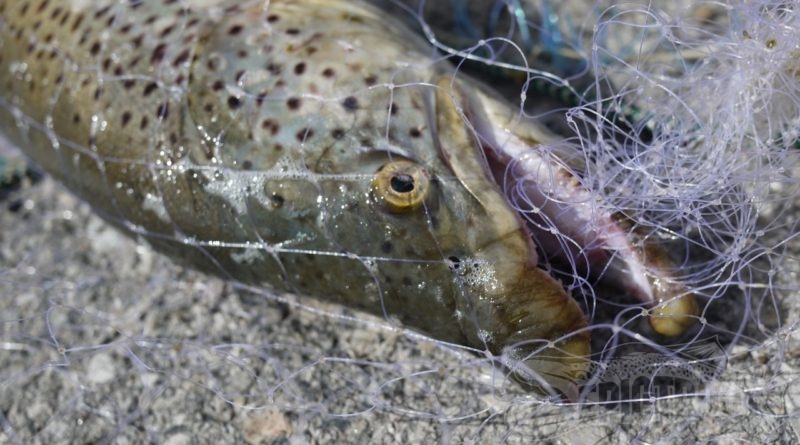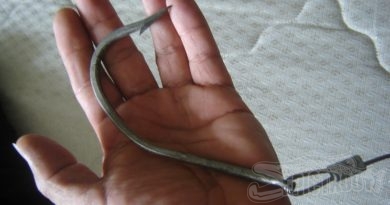Netting More Info
By Matthew Carollo


Years ago, when I first learned that my favorite brown trout fishing hole was gillnetted twice a year, I was deflated. Seeing nice sized trout that get caught in gillnets and die seemed like a waste. I learned later that the information and samples collected from the Fish and Game Department is indeed crucial to sustaining a healthy fishery. In these studies, growth rates, stomach contents, location, mercury levels and species identification are very well documented and, surprisingly to many, this information is available to the public. I talk with my local biologist on a regular basis and help out however I can when local surveys are conducted. This has helped me to better understand the changes that occur in my local rivers and lakes from year to year. Gillnetting and Electrofishing are the two main fish sampling techniques used.
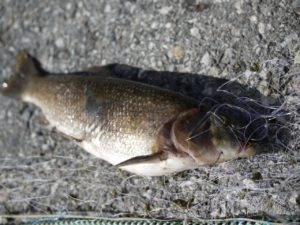 Recently, the Fish and Game Department conducted their Spring survey and soaked eight gillnets overnight. Next morning they were pulled from the lake and examined. Each fish is identified, measured, weighed. New fat growth and stomach contents are analyzed. Also, meat from the trout and bass is filleted and donated to eat. The eight gillnets are placed around the lake in the same locations twice each year which helps me to understand which sides of the lake are holding more fish. I also like knowing the contents of the fish’s stomachs so I can replicate it. So I take pictures of the baitfish and use those to help me paint more realistic lures.
Recently, the Fish and Game Department conducted their Spring survey and soaked eight gillnets overnight. Next morning they were pulled from the lake and examined. Each fish is identified, measured, weighed. New fat growth and stomach contents are analyzed. Also, meat from the trout and bass is filleted and donated to eat. The eight gillnets are placed around the lake in the same locations twice each year which helps me to understand which sides of the lake are holding more fish. I also like knowing the contents of the fish’s stomachs so I can replicate it. So I take pictures of the baitfish and use those to help me paint more realistic lures.
This springs’ gillnet survey was the best sampling of brown trout I have witnessed in the last three years. I noticed a few differences in this recent survey, which may have contributed to a higher yield of brown trout. These differences included cooler water temps, lower water levels and wetter weather conditions. When the nets were set on the evening of a rainy, low-pressure front I knew right away they would get some good brown trout activity. In past years, samplings were conducted during high pressure with blue skies and warmer water temps.
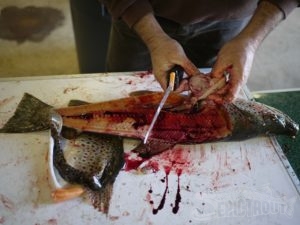
The nets mostly contained large 12-20 inch Utah chubs but several brown trout, rainbow trout and Smallmouth bass were also caught. There is a huge population of mature chubs in the lake and not many small chubs. This could indicate the larger predator fish are eating lots of the chub fry before they can grow large enough to escape. Although the chubs out number all other species in the lake, the sampling of trout caught this year was enough to renew my faith in one day catching a big brown trout.
The largest brown gillnetted was approximately 8 pounds and 27 inches long. Judging by it’s faded color it swam into the shallow-water net, early the night before. It was a healthy fish with a high amount of new fat growth around its organs and inside its belly the remains of an 8 inch rainbow trout. It was caught in the same net as the largest bass, a 5 pound 20 inch Smallmouth. That net also had the highest number of chubs. The net was set and pulled from a point on the lake that I don’t often fish. You can bet I will be fishing there first thing Saturday morning with a chub painted lure tied on!
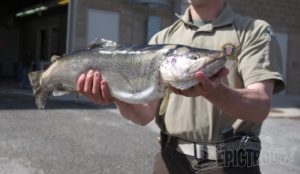
Several other 20-25 inch Browns were sampled from the opposite side of the lake. The 25 inch hook-jaw pictured here was still alive when the net was brought onto shore therefore it must have swam into it in the late morning hours. It had nothing in its stomach whereas the other browns and bass caught in the same net had the remains of 5 inch yellow perch and 3 inch bass fry. The smaller browns and rainbows sampled throughout the lake had sow bugs, snails and zooplankton in their stomachs.
On those slow days of fishing, anglers often dream about what’s lurking below but fish biologist get to really find out. Any smart angler would use this information to their advantage increasing their chances of catching the fish of a lifetime.
Thanks,
Matt Carollo

